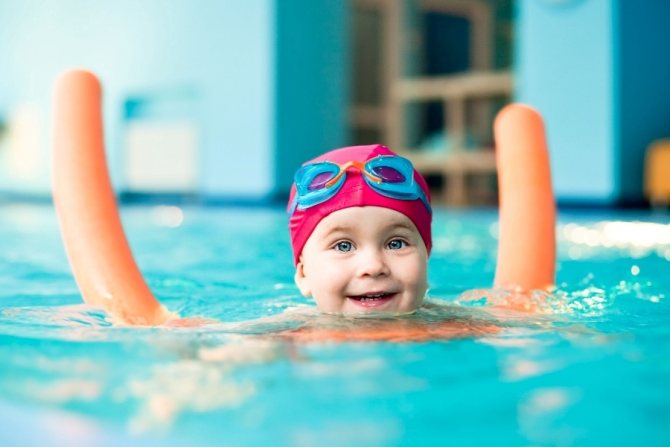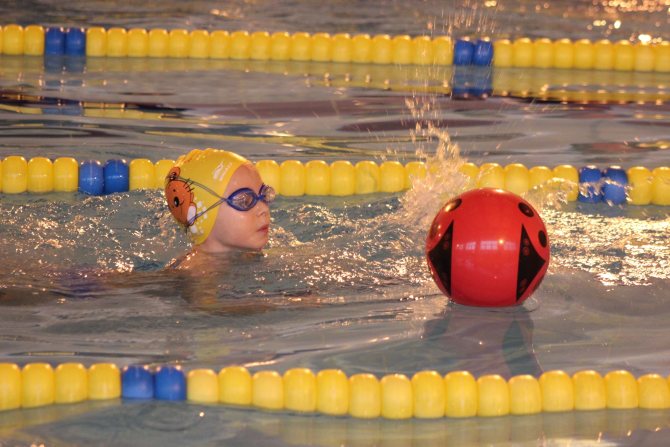Developing a child: swimming lessons for children
It is known that swimming is one of the most effective and safe ways to strengthen and develop the body.
Medicine encourages children to get used to water and physical activity in it almost from birth. Modern pediatricians and pediatric neurologists recommend starting to bathe children 2 to 3 weeks after birth, since swimming contributes to the balanced physical development of the child, including:
- relieve tone and relax muscles;
- normalization of neurological processes;
- muscle training.
It is important to understand the difference between regular water activity and swimming training. And since the next stage in accustoming a child to water after a home bath is swimming in the pool, you need to know when you can send your child to swim.
At what age can you take your child to the pool and teach him to cry?
Swimming instruction is definitely not necessary for babies and toddlers - and it's not for every child, every baby is different. The group currently supports swim lessons for children 1 year of age and older who show signs of pool readiness and are frequently exposed to water.
With a child in the pool
If your little one seems ready for a splash in something more than a bathtub, discuss the topic of swim lessons with your pediatrician, who can give you a better idea of where your baby is developmentally, emotionally and physically, and make recommendations. suitable program in your city.
At what age should I send my child swimming?
You can send even the smallest child, a newborn child, to swim, and this practice is very popular today. Parents are often confident that early visits to the pool perfectly develop the child, form a sporty and healthy lifestyle, and help strengthen the child’s body, discipline and mental growth.
However, introducing a baby to the pool is fraught with a number of negative consequences:
- there are no qualified trainers for teaching swimming to infants - at best, the trainer will be a person with a secondary medical education; more often - people without qualifications;
- for such classes there is no proven and proven methodology - most “trainers” train children according to programs that do not have the approval of the Ministry of Health or other competent organizations;
- swimming during infancy can cause epileptic seizures;
- the formation in children of almost irreversible incorrect swimming skills (swimming in a vertical position, etc.).
Thus, if the purpose of visiting the pool is precisely to develop swimming skills, and not to spend leisure time, then it is better to wait a few years. And then decide how seriously you want to approach this issue.
There are 2 purposes for which parents teach children to drink water:
- learning to swim so that the child can “be friends” with water and feel confident when traveling to the sea and other bodies of water;
- make an athlete out of a child - a professional swimmer.
The earliest date from which it makes sense to take a child to the pool and not harm his future is 4 years.
For amateur purposes, there are no other restrictions, you can come to the pool for the first time at both 10 and 12 years old, the child will become an excellent swimmer if you choose a good coach and have not been taught the wrong swimming habits before. Children with already formed incorrect swimming skills are not so easy and sometimes impossible to re-teach even by a very experienced teacher.
For sports purposes, the optimal period is 5–6 years.
It is important to pay attention when choosing a swimming center:
- at what age are children accepted there - if from infancy, then it means that the institution practices classes without a scientifically based methodology;
- what are the qualifications of the coaches - they should be professional swimmers with the titles of candidates or masters of sports or teachers with a specialty in “swimming instruction”; Experience is also important - the more, the better;
- methodology - whether the methodology of the All-Russian Swimming Federation is applied;
- characteristics of the pool - a special pool with a depth of no more than 0.6 m.
In any situation, the classes for both amateurs and future sports masters will initially be the same, since the child needs to be taught the basics and consolidate them, this is a kind of elementary school. After passing this stage, the format and methodology of classes will differ between classes.
Taking a child to the pool: warnings
A number of scientific studies over the past decade have confirmed a link between children swimming in chlorinated pools and the development of allergies and asthma. One of the most frequently cited publications from Belgium, published online in 2009 in pediatrics.
Children were monitored for bath time. It was about indoor swimming versus outdoor swimming; tests were carried out on their lung and blood function. The study found that swimming in chlorinated water increases the risk of asthma (eight times more likely) and hay fever (three to six times more likely).
The idea is that while chlorine interacts with organic matter such as sweat, urine and hair, it creates byproducts such as trichloramine and methane. The fumes, which can help allergens enter the body through damaged respiratory membranes and surfaces, are especially deeply inhaled by swimmers during intense exercise.

When can you go to the pool with your child?
Before you go to the pool with your child, remember:
- Not all children are equally susceptible. Based on their genetic makeup, some children may be more sensitive to chlorine byproducts.
- The duration of exposure is also important. Some of the children who swam less were more likely to develop asthma.
- If you are concerned about chlorine levels in your pool, watch for side effects such as eye and skin irritation.
- There are some classes that teach children about water safety - starting at six months. Water activities for children have become more popular recently, most likely because parents want young children to at least be able to swim, in the hope that it may prevent drowning.
But official recommendations from pediatric organizations suggest that a child is ready for swimming lessons by age 4.
The benefits of swimming in a pool for children
Swimming has a positive effect on the general condition of the child. In particular, this sport has the following advantages:
- relieving stress, negative thoughts, poor emotional state - improving mood, appetite, sleep, peace of mind;
- strengthening immunity and hardening;
- gymnastics for the respiratory system - thanks to the pressure of water on the chest, the child takes deep breaths and exhales, powerful ventilation of the lungs starts;
- like any sport, swimming develops and strengthens the circulatory and cardiac systems;
- development of motor skills, coordination;
- during exercises in water, the compression from the back is removed - the child’s spine does not experience the usual load, a straight posture is formed, the child stretches in height;
- working all the muscles of the body is the most useful physical activity;
- nurturing endurance and self-discipline.
Swimming is an excellent addition to a child’s training in other sports - swimming will help the child practice successfully and enhance the effect of physical activity.
Pool safety: how to give your child first aid?
Despite the fact that swimming lessons take place under the close supervision of an experienced coach and parents, unforeseen situations may occur that require a lightning-fast response.
If it happens that a child “dives” unsuccessfully or falls into the water, the following actions should be taken:
- The child must be placed in an upright position without being pulled out of the water. He should remain submerged in water up to his shoulders. You should allow the child to sneeze and cough well on his own, take a couple of deep breaths, and also show all the emotions associated with an unsuccessful dive (crying, screaming, etc.). Such behavior of children will indicate that they are no longer in danger and are in satisfactory condition. At the same time, the parents themselves should remain calm, while not forgetting to praise the child for his courage and diligence, so that he has as few negative memories of what happened as possible.
- If, after the manipulations described in the first paragraph, the baby does not recover breathing for more than 7 seconds, he should be placed on the inside of his own forearm with his chest down. The fingers of the same hand should securely fix the child’s shoulder. With the other hand (palm), a couple of patting movements are performed between the shoulder blades in the chest area. As soon as the baby starts coughing and screaming, expressing protest, you should immediately immerse him in the water vertically, not forgetting to constantly praise him for his courage.
- If none of the above options worked, and the child still cannot take a breath, the skin begins to acquire a bluish color, you should immediately place the baby on a bent leg with his chest. Next, we perform patting movements between the shoulder blades on the back, wait a while until sneezing, coughing and protesting appear.
All the described actions will help to avoid trouble and reduce the child’s stress from an unsuccessful acquaintance with the pool.

How to choose a swimming coach for children?
The safety and health of the child, as well as his psychological state, depend on the coach.
Parents should be confident that their children are being taught by someone with the following qualities:
- former professional swimmer with the title of master or candidate master of sports;
- teacher specializing in swimming coach;
- uses a methodological program in the classroom;
- work experience 3 – 5 years;
- gets along with children.
It is important that the child feels psychologically comfortable during lessons with the chosen teacher. Parents are advised to periodically attend their child’s classes and observe how the classes are conducted, and also simply ask if he likes his coach.
If it is difficult for a child to learn from a particular teacher, it is better to change the coach.
After two: improve posture
Two to three years is the ideal age for swimming. It is at this time that the baby’s posture is actively developing, and the load on the spine is relieved in the water. Swimming also strengthens bones, is an excellent prevention of flat feet and increases endurance. And, of course, every time, returning from the pool, the baby will amaze you with a ravenous appetite and sleep soundly, healthyly.
But keep in mind that swimming will only benefit you if you don’t take the exercise too seriously. Experts insist that up to 5 years old, a swimming pool should be fun for a child. You need to go to practice no more than once or twice a week, but you don’t need to teach him to swim. You can show some movements, “drive” the child along the surface of the water so that he feels it and gets used to it, the main thing is to do what he likes! After all, at this age, many children are afraid to swim, and only games and fun splashing can destroy the fear. Choose a fitness club that has a shallow children's pool and a smiling trainer. It’s better if you sign up your little one for group classes: even if the little one is terrified by the mere thought of touching the water with his heel, in the company of his peers he will cope with his phobias faster. Carefully watch the child frolicking in the water. Stop exercising immediately if he has the effect of “marbled” or “goose bumps” and if it becomes bluish in color – these are the first signs of hypothermia. Pull your baby out of the water if he is overexcited, restless, or just tired. Have you noticed that all of the above is repeated often? Be sure to take a break from classes or put off swimming altogether for a few years. If at this age a child develops a negative attitude towards swimming, then you will no longer be able to drag him into the water.
With all the advantages, swimming in the pool also has its disadvantages. Even conscientiously purified water can harm young Ichthyander. This is especially true for children with dry and allergy-prone skin. Any element of disinfection, be it ozone or chlorine, loosens the baby’s epidermis, which makes it easier for bacteria to “access the body,” which is abundant in most pools.
Useful information about swimming
Tips for parents:
- Before starting training, go to an appointment with a pediatrician and make sure that your child has no contraindications to training in the pool:
- kidney disease;
- heart failure or heart defects;
- convulsions;
- allergies;
- joint diseases;
- and etc.
- After classes, be sure to work on your baby’s ears for a while with ear sticks to remove any water that has gotten into them.
- Take the child out of the center building with a dry head and in thick clothing.
- Don’t be afraid of your child’s cold at the initial stage of training - the child is hardened and his immunity increases.
- If a child attends classes without enthusiasm, find out the reason and try to change the coach or the pool itself; Perhaps the child does not have enough friends in classes, you can agree with the parents of familiar children about joint training.
- If your baby gets overexcited at every lesson, cries, screams and otherwise expresses anxiety, it is better to suspend the lessons or simply postpone them for several months or years. After a while, you should invite the child to go to the pool again.
At what age can you enroll a child in the section?
Parents, having learned about the benefits of swimming, begin to look for where the swimming section for children is located. But don’t immediately drag your newborn into the pool. He should get a little stronger and recover from childbirth. This may harm his body.
Physical education means
There is a special liquid in the mother’s stomach; there is no need to perform any actions or swim there. The amniotic fluid does not have the required temperature and there are no differences. The child’s body has not fully adapted to the environment. An infection can get through a wound in the navel. Therefore, even though water is a familiar place for a baby, it is better to wait a little.
The first step in a baby’s swimming journey will be the bath. Then the classes are mastered in the pool, and then in open reservoirs. Bathing areas must be clean.
Children's swimming school will be needed only after 2 months. A prerequisite is that the umbilical wound must heal completely and not ooze. The pediatrician can always assess the child’s condition and give the right advice.
Important! At first, classes are short and under the strict guidance of a specialist!
A child can start swimming consciously and understanding what exactly to do at the age of 5. Therefore, you should not expect serious results from it. He is not yet able to understand why this is all happening. To learn swimming, you need to attend more than 10 lessons. But not everyone succeeds.

Preschooler swimming lesson
The children's pool acts as a regulator of the daily routine.
On time and after effective training, the baby’s metabolism increases, the child’s appetite awakens and there is a need to restore wasted energy. Already at school age, the pool charges with energy, the child learns the school curriculum more easily. The presence of training forces parents to organize their child’s daily routine, which has a positive effect on the child and the parent.

photo courtesy of the Jolly Penguin children's pool
What harm can a swimming pool cause for children?
Let's start with the fact that classes cannot take place in the pool. Water is the natural habitat of humans. However, many physical activities may have their own contraindications. It seems to us that there should be no equal sign between contraindication and harm. Contraindications are usually associated with some diseases, the manifestation or exacerbation of which can harm the child. For example, you do not need to go to the pool if you have skin diseases, epilepsy, heart defects, etc.
It is not for nothing that the pool workers, along with a certificate for eggworm and enterobiasis, require a certificate from the pediatrician, which will indicate that the child is healthy or can visit the pool. Water is as dangerous as it is beneficial. We encourage parents to check their child's health for any contraindications to visiting the pool.









